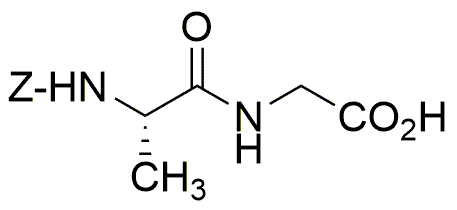Z-Ala-Gly-OH is widely utilized in research focused on
- Peptide Synthesis: This compound serves as a building block in the synthesis of peptides, which are crucial in drug development and biochemistry. Its structure allows for the formation of diverse peptide chains, enhancing the potential for novel therapeutic agents.
- Biochemical Research: Researchers use Z-Ala-Gly-OH to study protein interactions and enzyme activities. Its role in mimicking natural amino acids aids in understanding biological processes at the molecular level.
- Pharmaceutical Development: The compound is important in the pharmaceutical industry for developing new medications, particularly those targeting metabolic disorders. Its stability and compatibility with various formulations make it a preferred choice.
- Cosmetic Applications: In the cosmetic industry, Z-Ala-Gly-OH is incorporated into formulations for skin care products. It helps in enhancing skin hydration and elasticity, making it beneficial for anti-aging products.
- Food Industry: This compound can be used as a flavoring agent or preservative in food products, contributing to improved taste and shelf life while ensuring safety and quality.
General Information
Properties
Safety and Regulations
Applications
Z-Ala-Gly-OH is widely utilized in research focused on
- Peptide Synthesis: This compound serves as a building block in the synthesis of peptides, which are crucial in drug development and biochemistry. Its structure allows for the formation of diverse peptide chains, enhancing the potential for novel therapeutic agents.
- Biochemical Research: Researchers use Z-Ala-Gly-OH to study protein interactions and enzyme activities. Its role in mimicking natural amino acids aids in understanding biological processes at the molecular level.
- Pharmaceutical Development: The compound is important in the pharmaceutical industry for developing new medications, particularly those targeting metabolic disorders. Its stability and compatibility with various formulations make it a preferred choice.
- Cosmetic Applications: In the cosmetic industry, Z-Ala-Gly-OH is incorporated into formulations for skin care products. It helps in enhancing skin hydration and elasticity, making it beneficial for anti-aging products.
- Food Industry: This compound can be used as a flavoring agent or preservative in food products, contributing to improved taste and shelf life while ensuring safety and quality.
Documents
Safety Data Sheets (SDS)
The SDS provides comprehensive safety information on handling, storage, and disposal of the product.
Product Specification (PS)
The PS provides a comprehensive breakdown of the product’s properties, including chemical composition, physical state, purity, and storage requirements. It also details acceptable quality ranges and the product's intended applications.
Certificates of Analysis (COA)
Search for Certificates of Analysis (COA) by entering the products Lot Number. Lot and Batch Numbers can be found on a product’s label following the words ‘Lot’ or ‘Batch’.
*Catalog Number
*Lot Number
Certificates Of Origin (COO)
This COO confirms the country where the product was manufactured, and also details the materials and components used in it and whether it is derived from natural, synthetic, or other specific sources. This certificate may be required for customs, trade, and regulatory compliance.
*Catalog Number
*Lot Number
Safety Data Sheets (SDS)
The SDS provides comprehensive safety information on handling, storage, and disposal of the product.
DownloadProduct Specification (PS)
The PS provides a comprehensive breakdown of the product’s properties, including chemical composition, physical state, purity, and storage requirements. It also details acceptable quality ranges and the product's intended applications.
DownloadCertificates of Analysis (COA)
Search for Certificates of Analysis (COA) by entering the products Lot Number. Lot and Batch Numbers can be found on a product’s label following the words ‘Lot’ or ‘Batch’.
*Catalog Number
*Lot Number
Certificates Of Origin (COO)
This COO confirms the country where the product was manufactured, and also details the materials and components used in it and whether it is derived from natural, synthetic, or other specific sources. This certificate may be required for customs, trade, and regulatory compliance.


